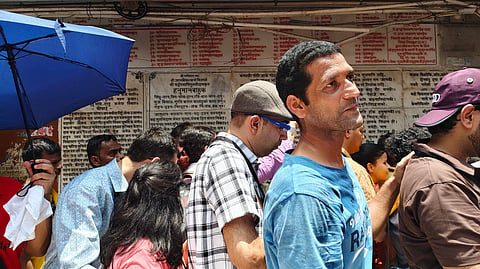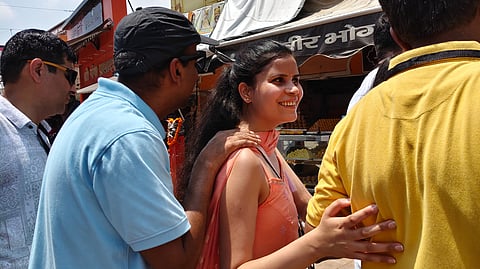Jagdish Chander clutched a white cane and a volunteer’s hand and boarded a bus bound for Ayodhya, eager to visit the temple city—not through sight, but through sound and touch.
Experiencing Divine Faith Through the Eyes Of The Visually Impaired
In the last week of June, a group of visually impaired persons visited the Ram Temple in Ayodhya. They share their experience of viewing the temple through the power of their senses and feelings
“Even if I am not able to see, I hear as much as I can. I like to touch things; I like to get a description of the place. And I like to create a memory of the place like this,” the 57-year-old says. You hear the birdsong. The freshness in the air, the suffocation in the closed room—you don’t see these things, you feel them, he adds. “When you close your eyes, you can simply sense a place,” says Chander.
He is a Political Science professor at Hindu College within the University of Delhi. He lost his vision to optic atrophy at the age of six.
Chander joined a group of 35 visually impaired persons who visited the Ram Temple in Ayodhya from June 26-29. Volunteers guided them up the steps of the bus, seat by seat, placing their name tagged bags underneath their seats.
For most, it was their first journey to the holy city. As the bus doors closed behind them and the vehicle left Delhi, reaching the Yamuna Expressway, a quiet resolve settled over the group. The road ahead stretched 14 hours, with Bollywood classics blaring from the speakers and passengers dancing, hand in hand.
Next stop: Ram Temple. As they moved in queues along the roadside—name tags around their necks and shirts that read ‘Yes I Can Travel’—bystanders paused. Some watched in awe, others with sympathy, and many with quiet respect.
The group was diverse: devout pilgrims, agnostics, people of different faiths, school students, government employees, and university professors—united not only by their destination, but by the camaraderie that only forms on journeys like this.
“Jai Shree Ram”, one of them chanted, as others paused to buy fridge magnets and keychains of Ram Lalla—the child form of the deity whose idol was installed in the temple inaugurated last January.
The temple has become a dham—a place of pilgrimage. As one neared the temple complex, the air grew thick with the scent of incense, and street lamps shaped like Ram Baan—the divine, unfailing arrows of Ram. As the volunteers helped put the group’s shoes, bags and phones in lockers, many members in the group asked for the precise description of the place.
The temple—still under construction—was described to the group as they walked slowly toward the sanctum. “That is the sound of the work going on,” a volunteer explained. “It is grand pillar, built of pink sandstone,” another added. As they navigated the narrow pathways, specially made for people with disabilities, quiet conversations broke out—echoes of shared joy.

Umesh Bhatt, who lost his sight two years ago after a spike in blood pressure, began singing bhajans. “One does not need vision to visit a temple. What matters is internal purity,” he says. He had not come to ask anything of Ram—but to say thank you. “This is the second chapter of Umesh Bhatt. And I am glad I am blind now; desire no longer distracts me,” he says.
A devout man, Bhatt chants, meditates every day for an hour or more. He has devoted his life to spirituality. He joined the group by chance, having recently moved to Delhi for a radio jockey course. “I am here so Hanuman can see me—not the other way around. I felt the vibrations. I touched the carvings. That is enough,” he says. But not everyone in the group shared Bhatt’s deep religiosity. Some had come simply for the cultural experience.

“Religion and temples hold a significant place in the lives of many visually impaired people,” says Chander. He recalled how his mother would take him to temples and spiritual healers known for supposedly restoring sight.
Raised in what he described as a secular, leftist environment in Delhi’s North Campus during the late 1980s, Chander says his views had evolved over time. “I am a secular person. I respect religion, but I know for a fact that God is not real. Religion is a social construct—the opium of the masses, as Karl Marx put it,” he says.
He joined the group trip to Ayodhya, marking his third trip this summer. Reflecting on his travels across India and abroad, he highlighted the difference between impairment and disability. “Blindness, per se, is not my disability—it is an impairment. It is the disabling environment that turns it into a disability,” he explains.

Amar Jain, who was born visually impaired and practises law at the Delhi High Court and the Supreme Court, says: “Temples assume that everyone who comes will simply see God and feel happy. But there are people who cannot see the deity. They need a different sensory experience—to be able to touch, to feel, to hear, to smell, and even to taste.”
He adds: “The point is that we have five senses, and we can use many of them to absorb information, shape our beliefs, and form our own opinions. That is how visually impaired people perceive God—through other characteristics. There, however, was no space to touch things or experience them at the Ram Temple. Independent accessibility is missing.”
In contrast, Jain recalled his earlier visit to Badrinath, where he trekked alone, guided by the sounds of rivers, birds, and devotional chants. A religious person by nature, he was accompanied by his wife on the trip to Ayodhya.

“God does not reside in idols or temples,” says 29-year-old Meenakshi Chaturvedi. Raised in a hostel away from home, Chaturvedi now works at the Defence Research and Development Organisation. When asked why she chose to visit Ayodhya despite her beliefs, she says: “I do sometimes resent God, but I know being blind is not a punishment.”
She joined the trip to escape daily logistics and be among others who understood the lived experience of visual impairment.

Her sentiments were echoed by 19-year-old Shiva Kumar, a Psychology student. Quoting the Bhagavad Gita, he says religion is something to be felt and lived—not found in temples. “People have turned religion into a business. They feed God, bathe the idols—but for what? That food could go to the millions still hungry in India. The idol is not alive,” he says.
Like all temples, the idol of Ram Lalla at Ayodhya underwent a Pran Pratishtha ceremony—a grand consecration ritual that means establishing the life force—in January 2024. The ceremony, attended by the Prime Minister, was broadcast live.
The Pran Pratishtha was a historic moment, taking place after the Supreme Court’s landmark ruling on November 9, 2019. In that judgment, the court decided on the cross-appeals filed by the Hindu and Muslim sides challenging the 2010 three-way division of the disputed 2.77 acres of Ram Janmabhoomi-Babri Masjid land among Ram Lalla, Nirmohi Akhara, and the Sunni Waqf Board. In a unanimous verdict, the Bench ordered that a temple be constructed at the disputed site and that Muslims be given five acres of land at a prominent location in Ayodhya as compensation. Since then, the temple has held significance that extends beyond religion, into political discourse.

Chander, who believes that the construction of the Ram Temple was pure politics which helped the ruling party win General Elections, recalled his university days and the vibrant political consciousness of that period. He was a young professional, having recently joined Hindu College as a professor, when L.K. Advani’s Rath Yatra and the Babri Masjid demolition took place. He remembered the protest chants—dharti baati, sagar baata, mat baato insaan ko.
“There were progressive groups that mobilised student demonstrations. There were late-night screenings of Ram Ke Naam and lectures by scholars discussing these developments,” he says.
Chander, who described himself as agnostic, laughed when a volunteer pointed out that the railing encircling the main temple was decorated with lotus motifs. The political weight of that symbolism was not lost on him.
This four-day Ayodhya trip was curated by Rising Star Khilte Chehre, a Delhi-based NGO that has already led 11 inclusive trips—from Dubai to Goa—for visually-impaired travellers. It now prepares its 12th journey, with volunteers and partners.
Tags